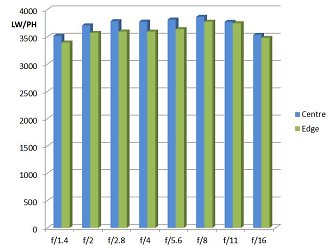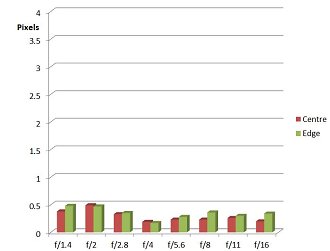Zeiss OTUS 55mm f/1.4 Lens Review
Zeiss OTUS 55mm f/1.4 Performance
This is a very complex lens, as well as the size and weight already mentioned. Compared to the usual standard lens it is huge, and Zeiss clearly are making no compromises in their quest for the optimum optical quality. The optical formula is a long way removed from the traditional 7 elements in 6 groups that we might expect from an f/1.4 standard lens.
Taking distortion first, this is held very well to -0.786% barrel. This is excellent and should pose no problems in general photography. In any event, corrections can be made in software.
Resolution is very high, and rarely, if ever, is such a high, even performance seen. Yes, there are differences in the figures from aperture to aperture, but it makes little practical difference whether we look at the centre or edge of the field or what aperture we use. It can be regarded as universally excellent, with aperture merely changing the depth of field. This is a remarkable performance indeed. A lens which is universally as sharp as we could wish for.
How to read our charts
The blue column represents readings from the centre of the picture frame at the various apertures and the green is from the edges.The scale on the left side is an indication of actual image resolution as LW/PH. The taller the column, the better the lens performance. Simple.
For this review, the lens was tested on a Nikon D810 using Imatest.
Chromatic aberration, or colour fringing, is also well under control, with figures hovering between one quarter and one half of a pixel. This is insignificant, and results in incredibly clean images of, for example, tree branches against sky. This clarity does give a different impression to the right images and is no doubt what Zeiss mean when they refer to a “medium format” look.
How to read our charts
Chromatic aberration is the lens' inability to focus on the sensor or film all colours of visible light at the same point. Severe chromatic aberration gives a noticeable fringing or a halo effect around sharp edges within the picture. It can be cured in software.Apochromatic lenses have special lens elements (aspheric, extra-low dispersion etc) to minimize the problem, hence they usually cost more.
For this review, the lens was tested on a Nikon D810 using Imatest.
The high sharpness does, however, seem to make the bokeh of the lens a little less smooth than some. This is a subtle point and depends very much on the subject matter and, compared to the major advantages of the lens, a minor criticism. A more substantial criticism is that there is no weather sealing. These days weather resistance is seen, quite rightly, as a major advantage and it's a disappointment that at this price level it is not included. Perhaps that would mean even more bulk and that was where the line was drawn.
Flare is also very well under control and it is quite difficult to induce any signs at all of artefacts and internal reflections. Under the most arduous conditions there may be a slight drop in contrast, but for all practical considerations flare is absent.
The only real limitation to performance seems to be the ability to focus accurately, and it does make an enormous difference to the results, especially at wide apertures. When it's right, it's stunning.
Value For Money
Value for money is always going to be a tough call for lenses at this price level. £2699 is a very high price for a 55mm f/1.4 standard lens, by anybody's standards. It is, however, on a par with the Leica Summilux-M Aspherical 50mm f/1.4 at £2999.
Alternatives for Nikon are the Nikkor 50mm f/1.4 G AF-S (£275) and Nikkor 58mm f/1.4 G AF-S (£1349). There is also the manual focus Nikkor 50mm f/1.2 AI-S (£699). Canon offer the EF 50mm f/1.4 USM (£232) and the EF 50mm f/1.2 L USM (£995).
For Canon and Nikon we also have the Sigma 50mm f/1.4 DG HSM Art Lens (£669), the Samyang 50mm f/1.4 AS UMC (£283), the Zeiss Milvus 50mm f/1.4 (£949), the Zeiss Planar 50mm f/1.4 (£559) and the Voigtlander 58mm f/1.4 Color Nokton SL II (£409).
So, what price do we put on the technical excellence of the Zeiss Otus lens? That is, in the end, a very personal choice.
Add your message
Please login here or if you've not registered, you can register here. Registering is safe, quick and free.
photodo Stats
428 MTF tests
74 in-depth photodo reviews
100+ users join each day
Help the lens community by reviewing or rating a lens today via our lens search
Latest Lens Reviews
- Chinon 28mm f/2.8 Vintage Lens Review
- Canon EF 70-200mm f/4L IS II USM Lens Review
- Samyang AF 85mm f/1.4 EF Review
- Sigma 70mm f/2.8 DG Macro Art Review
- Samyang AF 24mm f/2.8 FE Review
- Meike 50mm f/1.7 Review
- Tamron 70-210mm f/4 Di VC USD Review
- Lensbaby Burnside 35mm f/2.8 Review
- Asahi Super Takumar 50mm f/1.4 Review
- Asahi Super-Multi-Coated Takumar 135mm f/3.5 Review


